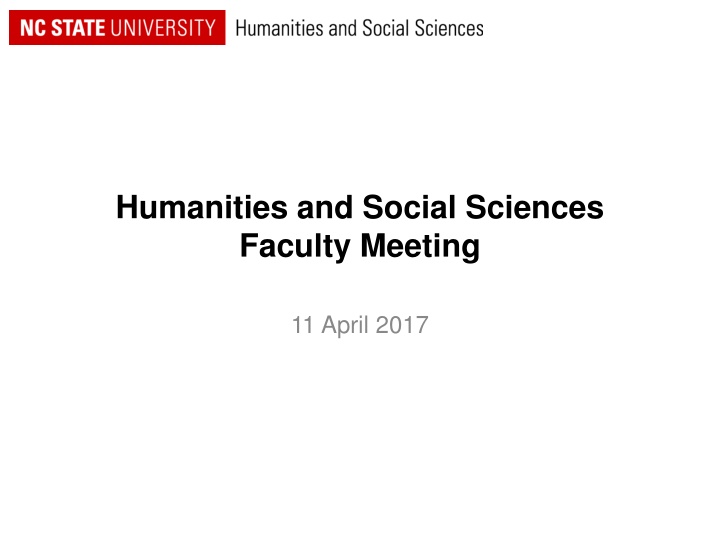
Navigating Budget Challenges at Humanities and Social Sciences Faculty Meeting
Explore the financial discussions and strategies from the Humanities and Social Sciences Faculty Meeting, focusing on current budget constraints and future considerations for the college. Discover insights on budget allocation, reserves, and implications for the upcoming years.
Download Presentation

Please find below an Image/Link to download the presentation.
The content on the website is provided AS IS for your information and personal use only. It may not be sold, licensed, or shared on other websites without obtaining consent from the author. If you encounter any issues during the download, it is possible that the publisher has removed the file from their server.
You are allowed to download the files provided on this website for personal or commercial use, subject to the condition that they are used lawfully. All files are the property of their respective owners.
The content on the website is provided AS IS for your information and personal use only. It may not be sold, licensed, or shared on other websites without obtaining consent from the author.
E N D
Presentation Transcript
Humanities and Social Sciences Faculty Meeting 11 April 2017
Overview This year s budget Next year s budget Right sizing our college Let s remember why we are here .
Closing FY 16-17 The college is $100K-$200K short We will close the books with a $0 balance by Saving whatever we can (If you have unspent money, we need it!) Exhausting F&A in units that are short Aggressively moving expenses to gift funds where allowed/appropriate We ll make it through this year but what about next?
Next Years (FY17-18) Budget Dean Tillman: The days of easy money are over! Dean Cahill: We re cutting our budget again this year.
The Big Picture University will return $11.6M (w/ no additional cuts) Why? We missed our 12-cell matrix projections 12-cell matrix linked to enrollment; we over-estimated Provost will divide his $7.1M reduction as follows: $4.6M reserves (this year only) $2.5M academic units capped at < 1% of base Our college s share: -$789,874 in SCH funding FY 17-18 (we went under) +$676,590 in SCH funding FY 18-19 (we hit targets) But: provost shares 50% of change, + 1% cap = -$353,381 for our college FY 17-18 +$296,752 for our college FY 18-19
Are we Ready for Winter? Dean s reserve for FY17-18 = $500K $353,381 goes back to provost 1 July $10,598 goes back to provost/GA for retention funds of faculty who resigned or retired $142,684 goes to departments for new commitments Targets of opportunity, retentions, spousal accommodations, etc. Leaves us -$6K entering this year Implications: No float Funds for new hires not guaranteed (depends on enrollment and resignations/retirements)
Principles to Drive Allocations Funding for departments should be at/near the college mean for 12-cell matrix $ Example for Dept. X 12-cell funding formula generates $5M (15-16 SCH) FY16-17 expenditures $4.5M Dept. funding = 90% of expenditures College average = 90% of expenditures Dept. X is at college average Therefore, FY17-18 budget remains the same (no change)
Funding Ratios for College Departments FY16-17 Expenditures/12-Cell SCH $ % of Funding Formula 117.84% 120% 112.13% 110% 99.40% 100% 89.79% 92.74% 87.37% 86.35% 90% 83.95% 78.01% 80% 70% 60% 48.43% 50% 40% 30% 20% 10% 0%
Strategies for Right-Sizing Increase credit hour production Data-informed course offerings, scheduling, etc. Increase student enrollment for majors, spring admits in 2018, meet GEP needs Meet graduate enrollment targets! Decrease expenditures College collects from departments > mean College allocates to departments < mean
Tactical Responses DE flex: Overload vs. general support Summer school (you keep 85% of what you make) Increase credit hour production w/out increasing costs Consider new/innovative models (e.g., online adaptive learning, flip lectures, large sections/TAs) Consider fairness within and among departments TA assignments vary from 1st semester 2/2 load to 3rd year 1/1 load across departments. Consider course load assignments by scholarship, subsidizing external entities (e.g., journals), engagement in graduate committees, etc.
Principles to Drive Budget Changes Changes should be gradual & predictable Initially: Ensure all departments have base budget to cover staff, T/TT faculty, and graduate assistantships Eventually: Right size with understanding that some nuance needed (e.g., writing intensive courses) Fairness requires consistency (but not rigidity) across college I will do my part: Dean s office (including salaries) 7.4% of total state $ Institutes and centers 1.2% of total state $ Lean overhead (most colleges 10-15%)
Pilot Project Offers Blueprint for Addressing Mental Health Needs of Homeless Children
Money, Not Access, Key to Resident Food Choices in Food Deserts
How Critical Thinking in the Humanities Reduces Belief in Pseudoscience
Students Documentary Captures Common Link Between Us: Humanity Laila Knio's The Common Link
Talking Black in America https://news.chass.ncsu.edu/wp-content/uploads/2017/03/Wolfram-Q-and-A-HEADER-992x558-768x432.jpg
Anil Dash Toward an Ethical, Inclusive Tech Industry






















